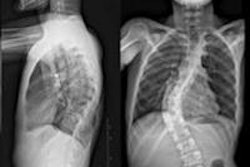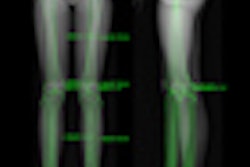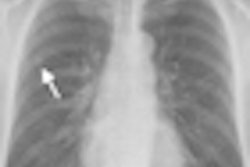French digital radiography (DR) firm Biospace Med of Paris is touting the results of a clinical study that shows that the company's EOS DR system has better image quality and lower radiation dose than computed radiography (CR).
In the study, a team led by Dr. Stefan Parent, Ph.D., of the Centre Hospitalier Universitaire Sainte-Justine in Montreal compared Biospace Med's EOS system to a commercially available CR unit (FCR 7501S, Fujifilm Medical Systems USA, Stamford, CT) in a group of 50 patients with spinal deformities. Results of the study were published in the April 20 issue of Spine (Vol. 35:8, pp. E344-E346).
Patients with spinal deformities such as scoliosis often require multiple radiographs for follow-up throughout childhood and adolescence, a practice pattern that has caused concern due to radiation exposure, the authors noted. The EOS system uses a slot-scanning design that results in lower radiation dose, while producing 2D and 3D images that have more clinical potential that conventional DR, according to the authors.
The patient population consisted of 39 females and 11 males, with an average age of 14.8 ± 3.6 years. Each patient was imaged on both the EOS system and a CR unit, with studies performed 15 minutes apart. Dosimeters recorded radiation dose, and a panel of two orthopedists and two radiologists judged image quality.
Radiation dose produced by the EOS system was much lower than from the CR system, ranging from a ratio of 2.9 times less at the nape of the neck (0.20 mGy for the EOS unit compared to 0.59 mGy for CR) to 9.2 times less at the proximal anterosuperior iliac spine (0.16 mGy for EOS to 1.47 mGy for CR).
Images for the EOS system in terms of global image quality were rated as better than CR for 46.7% of cases, equivalent to CR in 50.5%, and worse than CR in 2.8%. In terms of structure visibility, EOS was rated as better than CR in 32.4% of cases, equivalent to CR in 61.9%, and worse in 5.7%.
The authors concluded that the EOS unit has better image quality with lower dose, and the system's potential to acquire 2D orthogonal images to facilitate 3D surface reconstruction of the vertebrae and pelvis could have potential.
The authors disclosed that they received research funding from Biospace Med for the study, and after the conclusion of the study two of the authors reached a consulting agreement with the firm.
Related Reading
Biospace Med raises $18M, April 13, 2010
FDA clears Biospace Med's sterEOS for pediatrics, March 11, 2010
Road to RSNA, Digital X-Ray, Biospace Med, October 22, 2008
FDA OKs 3D mode for Biospace Med's EOS, October 8, 2008
Biospace adds Latin American distributor, November 30, 2007
Copyright © 2010 AuntMinnie.com



















